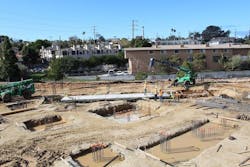Fully Compatible Treatment Train Fits Small Footprint
Introduction
Point Loma Peninsula, Calif. is an iconic land feature that jets out into the Pacific Ocean and completes the northern rim of the San Diego Bay. The peninsula has been described as “where California began,” marking the first landing point for European expeditions to present-day California. This moniker is especially fitting, as Point Loma has now become the landing place for the first UrbanPondTM. UrbanPondTM is a configurable storm water storage system that is providing developers and engineers access to underground capabilities. Within this well-known area, as with many other urban retrofits, every possible square foot is sought after, accounted for and maximized.
The Situation
Development opportunities or replacement projects in Point Loma are rare due to existing developments and topographical challenges. Site re-developments in this area require that new construction be more efficient and more creative with land usage in order to maximize opportunities in this region of steep hillsides and ocean fronts. The challenges of the topography require innovative solutions for architects and engineers.
The Challenge
Point Plaza Voltaire Apartments in San Diego, Calif., is a triangular redevelopment site featuring steep grading from the highpoint at the intersection of Voltaire and Las Lomas to the busy Nimitz Boulevard below. The builder’s goal for Voltaire was to replace an existing commercial building and asphalt parking lot with a multi-story apartment complex, street-side retail space and underground parking within a tight trilateral site. To accomplish this, thousands of pounds of earth were excavated and architectural plans were developed to maximize on the constrictive shape and dimensions of the space. However, the redesign would increase the imperviousness and density within the Voltaire site for a total drainage area of 24,323 sq ft. Runoff from the parking area and roof will pick up additional trash, debris and total suspended solids (TSS), but California regulations require full trash capture, while other permits call for bioremediation to promote infiltration. The challenges were adding up for Voltaire and jeopardizing their ability to reach developer goals.
The Solution
To solve both the storage and treatment needs, Bio Clean Environmental applied a treatment train of proven and compatible systems that address multiple site challenges. The UrbanPondTM system acts as a storage system to collect all of the site’s storm water runoff. The modules are 5 cm. tall inside to fit beneath the building’s parking structure. The modules are placed on a concrete foundation slab with multiple holes to promote infiltration and recharge the groundwater table below. Storm flows that outpace the underlying soils’ infiltration rate are conveyed into a cleanout/diversion structure downstream. An orifice within the diversion structure regulates flow into the Modular Wetlands biofiltration system.
The volume-based Modular Wetland (MWS-L-4-4-V) treats 2,200 cu ft of storm water with a 33 hr drain down time. Due to this treatment train of structures’ position below the street level, a pump system elevates the treated storm water to a curb outlet on Voltaire Street. This proven treatment train gives developers and design engineers a reliable solution. Each product fits within the site footprint, and without these devices, the redevelopment could have hit many challenges. Not only did the UrbanPondTM and Modular Wetlands storm water filter combination solve site constraints, but the Modular Wetlands is the only bioremediation device approved for downstream of detention usage.


